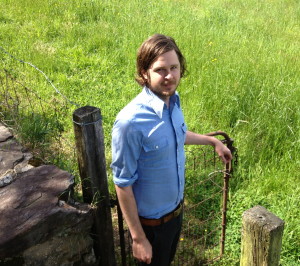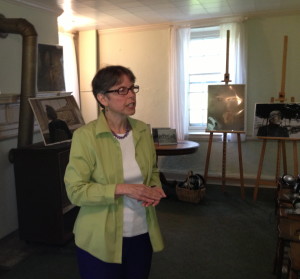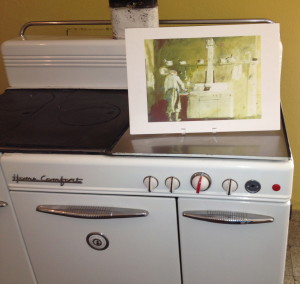Musical element aims to add new – and fleeting – dimension to visitors’ experience
By Kathleen Brady Shea, Managing Editor, The Times

Outside the Kuerner Farm in Chadds Ford, composer Michael Kiley said he found a wealth of sounds to incorporate into a composition that will fleetingly complement tours of the property, where artist Andrew Wyeth received inspiration for nearly seven decades.
The grant-imposed deadlines for curators at the Brandywine River Museum initially seemed prohibitive: eight weeks from start to finish to create an unconventional, ephemeral experience for visitors.
Now, several weeks into what evolved into an exhilarating race against the clock, the results are ready for public consumption – also with time constraints. On Monday, the museum will begin a two-week run of “Kuerner Sounds,” an evocative, sound composition by Philadelphia-area artist Michael Kiley.
Visitors who sign up to tour the Kuerner Farm – a Chadds Ford mainstay of the Wyeth legacy – can don headphones attached to an iPod Shuffle and listen to Kiley’s five-minute sonic homage to the property where Andrew Wyeth created nearly 1,000 works of art, a working farm where time has virtually stood still.

Brandywine River Museum Curator Mary W. Cronin discusses the Kuerner Farm “pop-up” musical experiment.
Curator Mary W. Cronin, who orchestrated the “pop-up” music experience with Christine B. Podmaniczky, said the grant from the Pew Center for Arts & Heritage required the creation of a fleeting element that would inspire visitors to think about their surroundings “in different ways.” The result? A sort of “now you hear it, soon you won’t” addition.
Cronin said they knew that Andrew Wyeth was keenly attuned to sounds. In fact, “Spring Fed,” one of many major works inspired by the Kuerners, evolved through Wyeth’s fascination with the spring water that steadily dripped into a cement trough in the milking barn. Cronin said the concept of complementing the farm’s milieu through sound drew them to Kiley, who had recently done a phone app for visitors to Philadelphia’s Rittenhouse Square that demonstrated “a sense of place.”
Kiley said he was up to the challenge, despite limited knowledge of the Wyeth dynasty. “I knew who he was,” Kiley said of Andrew Wyeth. After an intensive tutorial from the curators – which condensed nearly 70 years of Wyeth history at the farm into two hours – he knew substantially more.
On his first visit to the Kuerner farm, which Andrew Wyeth discovered on a boyhood walk, the 35-year-old composer said he found the federal-style farmhouse’s thick walls and musty smells “really spooky.” But that feeling quickly dissipated. “The more I settled in, the more comfortable I got, the more I realized how beautiful it was … It’s kind of awe-inspiring.”
Andrew Wyeth shared that sentiment. German emigrants Karl and Anna Kuerner fascinated him, especially Karl Kuerner’s tales about serving in the German army during World War I. The property had another hold on the young artist: In 1945, his father, N.C. Wyeth, was killed by a train at the railroad crossing near the edge of the farm.
After years of friendship with the Kuerners, Andrew Wyeth had free reign of the premises, sometimes even wandering around the inside of the home in the middle of the night. The property, now listed on the National Register of Historic Places, also introduced Wyeth to Helga Testorf, when she worked as a nurse caring for Karl Kuerner. That relationship generated a series of long-secret works in which Testorf posed nude for Wyeth. Additionally, the farm served as the setting for works including “Snow Hill,” “Groundhog Day,” “Young Bull,” and “Evening at Kuerners.”
Against that backdrop, Kiley found a treasure trove of sounds. From the chirping birds to buzzing insects to gurgling water, he said he used about 10 existing sounds in the piece, manipulating them, layering them with original tones, and anchoring them with the most prominent: the frogs. He said he became entranced with the property’s echoes, particularly around the barn, and in one sequence, he played a piano string with a thread to get the sound he wanted.
Kiley said he decided to add a song with lyrics to the piece because he felt that inclination and thought it would foster discussion. The words were inspired by Andrew Wyeth’s complex relationship to the farm, which included the loss of his father and his devotion to Karl Kuerner, Kiley said. “When you left, I wasn’t done pouring myself into you, Now I am left to search over tilted ground, I’ll have no shape to mold to, Until the inertia you created in me finds elsewhere to rest,” Kiley wrote.
Thomas Padon, the museum’s director, said he was enthusiastic about the initiative. “It’s a really interesting experiment,” he said. “It’s a fascinating way to recast the visitors’ experience … and to encourage new thinking.”
Tours of the farm, which will include the sound element from May 13-24, leave from the museum daily at 2 and 3:15 p.m. The cost is $8 in addition to regular museum admission, which is $12 for adults; $8 for seniors, $6 for students, and free for Brandywine Conservancy members. Tickets are limited, and may be purchased in advance at http://www.brandywinemuseumshop.org/Events.aspx or by calling 610-388-8326. Same-day tickets may be available at the museum admission desk.







